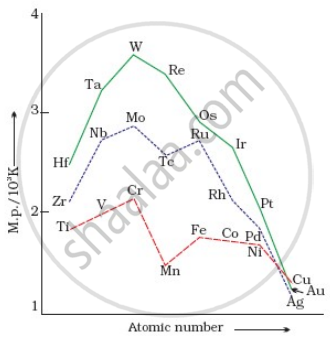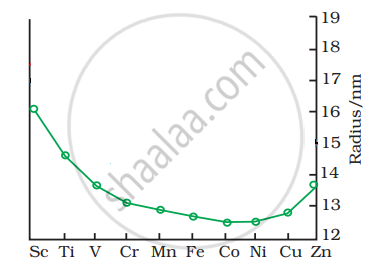Advertisements
Advertisements
प्रश्न
Explain why is Fe3+ more stable than Fe2+?
उत्तर
Electronic configuration of Fe2+ : 1s2 2s2 2p6 3s2 3p6 3d6
Electronic configuration of Fe3+ : 1s2 2s2 2p6 3s2 3p6 3d5
Due to the presence of half filled ‘d’ orbital, Fe3+ is more stable than Fe2+.
APPEARS IN
संबंधित प्रश्न
Calculate magnetic moment of `Fe_((aq))^(2+) ion (Z=26).`
What are the transition elements? Write two characteristics of the transition elements.
In what way is the electronic configuration of the transition elements different from that of the non-transition elements?
How would you account for the following:
Of the d4 species, Cr2+ is strongly reducing while manganese (III) is strongly oxidising.
How would you account for the following?
Zr (Z = 40) and Hf (Z = 72) have almost identical radii.
Write balanced chemical equations for the conversion of `CrO_4^(2-)` to `Cr_2O_7^(2-)` in acidic medium and `Cr_2O_7^(2-)` to `CrO_4^(2-)`
in basic medium.
Complete and balance the following chemical equations
`Fe^(2+) + MnO_4^(-) + H^+ ->`
Explain why transition elements form alloys.
In lake test for Al3+ ions, there is the formation of coloured ‘floating lake’. It is due to ______.
The magnetic nature of elements depends on the presence of unpaired electrons. Identify the configuration of transition element, which shows highest magnetic moment.
The magnetic moment is associated with its spin angular momentum and orbital angular momentum. Spin only magnetic moment value of \[\ce{Cr^{3+}}\] ion is ______.
Transition elements form binary compounds with halogens. Which of the following elements will form \[\ce{MF3}\] type compounds?
(i) \[\ce{Cr}\]
(ii) \[\ce{Co}\]
(iii) \[\ce{Cu}\]
(iv) \[\ce{Ni}\]
Transition elements show high melting points. Why?
When a brown compound of manganese (A) is treated with \[\ce{HCl}\] it gives a gas (B). The gas taken in excess, reacts with \[\ce{NH3}\] to give an explosive compound (C). Identify compounds A, B and C.
When an oxide of manganese (A) is fused with KOH in the presence of an oxidising agent and dissolved in water, it gives a dark green solution of compound (B). Compound (B) disproportionates in neutral or acidic solution to give purple compound (C). An alkaline solution of compound (C) oxidises potassium iodide solution to a compound (D) and compound (A) is also formed. Identify compounds A to D and also explain the reactions involved.
Answer the following question:
Which element of the first transition series has highest third ionisation enthalpy?
Identify the metal and justify your answer.
Carbonyl \[\ce{M(CO)5}\]
On the basis of the figure given below, answer the following questions:

- Why Manganese has lower melting point than Chromium?
- Why do transition metals of 3d series have lower melting points as compared to 4d series?
- In the third transition series, identify and name the metal with the highest melting point.
Read the passage given below and answer the following question.
|
Are there nuclear reactions going on in our bodies? There are nuclear reactions constantly occurring in our bodies, but there are very few of them compared to the chemical reactions, and they do not affect our bodies much. All of the physical processes that take place to keep a human body running are chemical processes. Nuclear reactions can lead to chemical damage, which the body may notice and try to fix. The nuclear reaction occurring in our bodies is radioactive decay. This is the change of a less stable nucleus to a more stable nucleus. Every atom has either a stable nucleus or an unstable nucleus, depending on how big it is and on the ratio of protons to neutrons. The ratio of neutrons to protons in a stable nucleus is thus around 1 : 1 for small nuclei (Z < 20). Nuclei with too many neutrons, too few neutrons, or that are simply too big are unstable. They eventually transform to a stable form through radioactive decay. Wherever there are atoms with unstable nuclei (radioactive atoms), there are nuclear reactions occurring naturally. The interesting thing is that there are small amounts of radioactive atoms everywhere: in your chair, in the ground, in the food you eat, and yes, in your body. The most common natural radioactive isotopes in humans are carbon-14 and potassium-40. Chemically, these isotopes behave exactly like stable carbon and potassium. For this reason, the body uses carbon-14 and potassium-40 just like it does normal carbon and potassium; building them into the different parts of the cells, without knowing that they are radioactive. In time, carbon-14 atoms decay to stable nitrogen atoms and potassium-40 atoms decay to stable calcium atoms. Chemicals in the body that relied on having a carbon-14 atom or potassium-40 atom in a certain spot will suddenly have a nitrogen or calcium atom. Such a change damages the chemical. Normally, such changes are so rare, that the body can repair the damage or filter away the damaged chemicals. The natural occurrence of carbon-14 decay in the body is the core principle behind carbon dating. As long as a person is alive and still eating, every carbon-14 atom that decays into a nitrogen atom is replaced on average with a new carbon-14 atom. But once a person dies, he stops replacing the decaying carbon-14 atoms. Slowly the carbon-14 atoms decay to nitrogen without being replaced, so that there is less and less carbon-14 in a dead body. The rate at which carbon-14 decays is constant and follows first order kinetics. It has a half-life of nearly 6000 years, so by measuring the relative amount of carbon-14 in a bone, archeologists can calculate when the person died. All living organisms consume carbon, so carbon dating can be used to date any living organism, and any object made from a living organism. Bones, wood, leather, and even paper can be accurately dated, as long as they first existed within the last 60,000 years. This is all because of the fact that nuclear reactions naturally occur in living organisms. |
Researchers have uncovered the youngest known dinosaur bone, dating around 65 million years ago. How was the age of this fossil estimated?
Read the passage given below and answer the following question.
|
Are there nuclear reactions going on in our bodies? There are nuclear reactions constantly occurring in our bodies, but there are very few of them compared to the chemical reactions, and they do not affect our bodies much. All of the physical processes that take place to keep a human body running are chemical processes. Nuclear reactions can lead to chemical damage, which the body may notice and try to fix. The nuclear reaction occurring in our bodies is radioactive decay. This is the change of a less stable nucleus to a more stable nucleus. Every atom has either a stable nucleus or an unstable nucleus, depending on how big it is and on the ratio of protons to neutrons. The ratio of neutrons to protons in a stable nucleus is thus around 1 : 1 for small nuclei (Z < 20). Nuclei with too many neutrons, too few neutrons, or that are simply too big are unstable. They eventually transform to a stable form through radioactive decay. Wherever there are atoms with unstable nuclei (radioactive atoms), there are nuclear reactions occurring naturally. The interesting thing is that there are small amounts of radioactive atoms everywhere: in your chair, in the ground, in the food you eat, and yes, in your body. The most common natural radioactive isotopes in humans are carbon-14 and potassium-40. Chemically, these isotopes behave exactly like stable carbon and potassium. For this reason, the body uses carbon-14 and potassium-40 just like it does normal carbon and potassium; building them into the different parts of the cells, without knowing that they are radioactive. In time, carbon-14 atoms decay to stable nitrogen atoms and potassium-40 atoms decay to stable calcium atoms. Chemicals in the body that relied on having a carbon-14 atom or potassium-40 atom in a certain spot will suddenly have a nitrogen or calcium atom. Such a change damages the chemical. Normally, such changes are so rare, that the body can repair the damage or filter away the damaged chemicals. The natural occurrence of carbon-14 decay in the body is the core principle behind carbon dating. As long as a person is alive and still eating, every carbon-14 atom that decays into a nitrogen atom is replaced on average with a new carbon-14 atom. But once a person dies, he stops replacing the decaying carbon-14 atoms. Slowly the carbon-14 atoms decay to nitrogen without being replaced, so that there is less and less carbon-14 in a dead body. The rate at which carbon-14 decays is constant and follows first order kinetics. It has a half-life of nearly 6000 years, so by measuring the relative amount of carbon-14 in a bone, archeologists can calculate when the person died. All living organisms consume carbon, so carbon dating can be used to date any living organism, and any object made from a living organism. Bones, wood, leather, and even paper can be accurately dated, as long as they first existed within the last 60,000 years. This is all because of the fact that nuclear reactions naturally occur in living organisms. |
Which are the two most common radioactive decays happening in human body?
A metallic ion 'M' reacts with chloride ion to form white precipitate which is readily soluble in aqueous ammonia. Identify 'M'?
The orientation of an atomic orbital is governed by
Which of the following statements is not correct?
Which of the following species has maximum magnetic momentum?
Give reasons for the following statement:
Transition metals and most of their compounds show paramagnetic behaviour.
Account for the following:
Ce4+ is a strong oxidising agent.
The trend of which property is represented by the following graph?

Explain the use of different transition metals as catalysts.
Why are interstitial compounds well known for transition metals?
